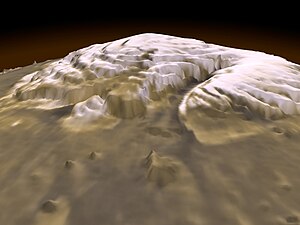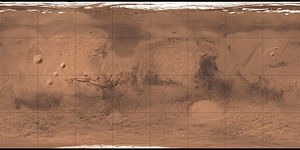Chasma Boreale
| Digging on Mars | ||
|---|---|---|
| Chasma Boreale | ||

|
||
| 3D map calculated from data recorded by Mars Global Surveyor | ||
|
|
||
| position | 83 ° 0 ′ N , 47 ° 6 ′ E | |
| expansion | 460 km | |
Chasma Boreale is a 560 kilometer long canyon in the northern polar cap of the planet Mars . It lies in the Planum Boreum at latitude 83 ° north and longitude 47.1 ° west (or longitude 312.9 °).
etymology
Chasma Boreale is derived from the Latin noun chasma (gorge, deep crevice, abyss) and the adjective borealis (north, wintry), meaning gorge of the north . Chasma in turn, ancient Greek χάσμα , comes from the verb χάσκειν or χαίνειν ( chainein - to open wide, yawn) and borealis in turn from the Greek god of the north wind Βορέας - Boreas .
description


The approximately 100 kilometers wide and 1,400 meters deep Chasma Boreale has cut 460 kilometers deep into the northern ice cap. Its mouth is 120 kilometers wide and tapers as it continues. As a result, the layer deposits ( areological unit Apu ) from the late Amazon were exposed on the side walls . The layer deposits are an alternation of water ice and dust-rich layers , which can be traced back to recurring dust storms. The dust layers are mostly dark to black in color, but can also have distinctive red tones. These alternating layers of ice and dust should provide valuable information for the reconstruction of the paleoclimate on Mars.
Dunes , streamlined objects and channels formed by the wind can be seen on the valley floor as special sedimentary structures. Two crater-shaped depressions at the proximal end of the chasm (at 84 ° N and 0 ° longitude), which are separated from one another by a local advance of the ice cap, are very noticeable . The craters exposed the Hesperian layer formation Hpu , which is obviously subject to the valley floor, which slopes gently up to the valley exit. The distal end of the valley floor (at 79 ° N and 55 ° longitude) forms a lobe, the edge of which rises 300 meters above the polygon-forming vastitas-boreale formation of the northern lowlands. The Lobus penetrates 100 to 150 kilometers into the foreland. In front of it are several cone structures, which Garvin referred to as volcanoes , as well as some sickle dune fields of the unit lApd .
Emergence
Fishbaugh and Head (2001b) interpret Chasma Boreale as a glacier structure , which was then morphologically overprinted in its late stage by the catabatic fall winds of the ice cap and sublimation processes. Melting processes leading to the liquefaction of the ice bed had already been considered by Clifford (1987). The cause of the melting process remains speculative; volcanism, meteorite bombardment, gravitational melting caused by the overload of the ice or a possible combination of these factors come into consideration. The meltwater breakthrough must have been gigantic. Upon reaching the upstream lowlands, the water ice flow slowed down and spread out in a fan shape. The river finally came to a standstill in a huge lake in the foreland and deposited a layer of sediment several meters thick. Several smaller chasmata in the neighborhood are considered to be of comparable origin. Katabatic processes are certainly important, but more so in the final formation of the spiral furrows on the ice cap itself and in the design of the dune fields in the chasm and in the foreland.
However, this is contradicted by Warner and Farmer (2008a), who advocate a predominantly Aeolian origin mechanism. Tanaka et al. (2008) also see no evidence of meltwater eruptions and rely on ablation in conjunction with wind erosion and gravitational mass movements.
Computer simulation of Chasma Boreale, based on the THEMIS instrument on Mars Odyssey
literature
- KE Fishbaugh, JW Head: Comparison of North and South Polar Caps of Mars: New Observations from MOLA Data and Discussion of Some Outstanding Questions . In: Icarus . tape 154 , 2001, p. 145-161 (English).
Web links
- DLR: Flight over Chasma Boreale at Mars' North Pole October 18, 2005
Individual evidence
- ↑ Dorling Kindersley Verlag GmbH: The Planets A visual journey through our solar system . Dorling Kindersley, Munich 2015, ISBN 978-3-8310-2830-6 .
- ^ J. Garvin: Topographic evidence for geologically recent near-polar volcanism on Mars . In: Icarus . tape 145 , 2000, pp. 148-152 .
- ↑ K. Fishbaugh, J. Head: The morphology of Chasma Boreale, Mars using MOLA data: Investigating mechanisms of formation . In: Journal of Geophysical Research . 2001.
- ^ S. Clifford: Polar basal melting on Mars . In: Journal of Geophysical Research . tape 92 , 1987, pp. 9135-9152 .
- ^ A. Howard: The role of eolian processes in forming surface features of the martian polar layered deposits . In: Icarus . tape 144 , 2000, pp. 267-288 .
- ^ NH Warner, JD Farmer: Importance of aeolian processes in the origin of the north polar chasmata, Mars . In: Icarus . tape 196 , 2008, p. 368-384 .
- ^ KL Tanaka et al.: North polar region of Mars: Advances in stratigraphy, structure, and erosional modification . In: Icarus . tape 196 , 2008, p. 318-358 .



